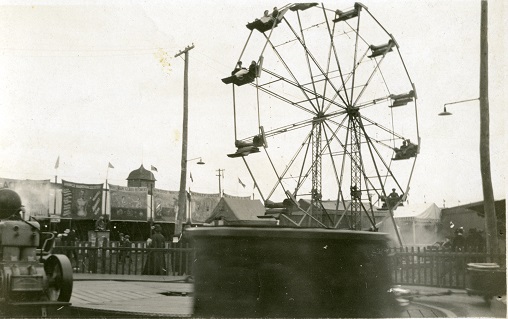

Partager
Horses, pigs, cows, sheep, flowers, fruit, vegetables, milk products, honey, maple syrup, machinery, and poultry (the latter including FIFTY categories of fowl). All – and more – were on display for the tens of thousands of people visiting Canada’s Great Eastern Exhibition held in Sherbrooke in the early 1900s.
For me, the Sherbrooke Fair is only a vague blip in my memory of childhood. While my family has always been faithful attendees and/or participants in the local fairs, the Sherbrooke Fair was not among those that we attended regularly. For some readers out there, however, the Sherbrooke Fair may hold fond memories of the exhibits, the livestock competitions, and the spectacle of it. And, in the early years of the fair: what a spectacle it was!
Founded in 1885 as the Eastern Townships Agricultural Association (ETAA), its beginnings came much later than its Townships counterparts in Bedford, Stanstead, Compton, Richmond, and Brome but it made up for its late debut with splash. The ETAA board of directors purchased part of the Terrill property on what was then Pine Street (later Parc Street, present-day du Cégep Street) for the exposition grounds and got to work building the grand stand, racetrack, dining hall, stables, and a machinery exhibition area. The first year of the fair, 1885, saw 15,000 visitors pass through the gates. Over the next four decades, this number would grow to 30,000 visitors on a single day at the height of the fair’s popularity.
From the beginning, the directors of the ETAA set their sights high and strove towards hosting an agricultural and educational event that went beyond the region to attract exhibitors from across the province, across Canada, and New England. In 1886, the ETAA won their bid to host the provincial and dominion exhibitions, positioning the Sherbrooke Fair as Canada’s Great Eastern Exhibition. In 1907, Sherbrooke again hosted the Dominion Exhibition and entered into the fair’s heyday.
New facilities and events were continually added to attract larger crowds. The grandstand went from accommodating 1,000 spectators to 8,500 by 1907, and over the years they added buildings to showcase hundreds of industries, businesses, arts and crafts, and expanded the facilities for livestock, including the Louis F. Codère building in 1949 to house the boys’ and girls’ Calf Club. Among the attractions featured at the fair over the years were a hot-air balloon launch and parachutist first included in 1888, an airplane fly-by in 1912, car races were added in 1923, which accompanied the pageants, acrobats, alligators, and visits from dignitaries that were among the long list of entertainment.
Some other notable highlights from the fair’s long history: a children’s day where children could apply for free admission to the fair (in 1928, 15,000 tickets were issued), for decades the mayors of Sherbrooke would declare a civic holiday for a day or half-day during the fair so that all residents could attend, and for at least a few years, included among the booths was that of the Post Office, where fair-goers could learn how to properly address letters and wrap packages.
While the Sherbrooke Fair’s decline can be attributed to a number of factors over decades, the first tangible signs can be seen with the loss stables and the 8,500-seat grandstand to fire in 1959 and 1961, and the demolition of many other buildings through the 1960s, which were never replaced in most cases. One particularly striking loss was the demolition of one of the fair’s most iconic buildings, the hexagonal main building, which was removed in 1966 to make space for the Palais des Sports and parking areas. This gradual move away from the agricultural focus of the fair was at least partly the result of the ETAA’s financial struggles and the consequential transfer of the fairgrounds property to the City of Sherbrooke in 1967.
The Sherbrooke Fair successfully celebrated their 100th year in 1985 but continued to decline into the early 1990s, when the Fair had to be cancelled in 1995 for financial difficulties. Fair organizers – by then the Corporation de l’exposition régionale agricole de Sherbrooke (CERAS)- were able to regroup for 1996 but in 1997, its final year, the fair was held without any sort of agricultural component and was followed by the dissolution of CERAS early in 1998.

Crédit photo: : P999/053/004/001 ETRC Postcard collection
View of the Main Building at the Sherbrooke Fair, 1913

Crédit photo: : P006/010/004/003 Minnie H. Bowen fonds
Midway, with ferris wheel, at the Sherbrooke Fair, 1919.

Crédit photo: : (P997/005.07/014 ETRC Textual Records collection
An illustration of the Sherbrooke fairgrounds in 1886.

Crédit photo: : (P244/003.01.01/004/001 Freeman Clowery collection
Directors of the Eastern Townships Agricultural Association, with fairgrounds visible behind them, in 1905. From left to right, standing: unknown, H.R. Fraser, L.A. Bayley, unknown, William Morris. Seated: E.W. Farwell, John Blue, James McKinnon, J.F. Learned, J.H. Walsh and Dr. P. Pelletier